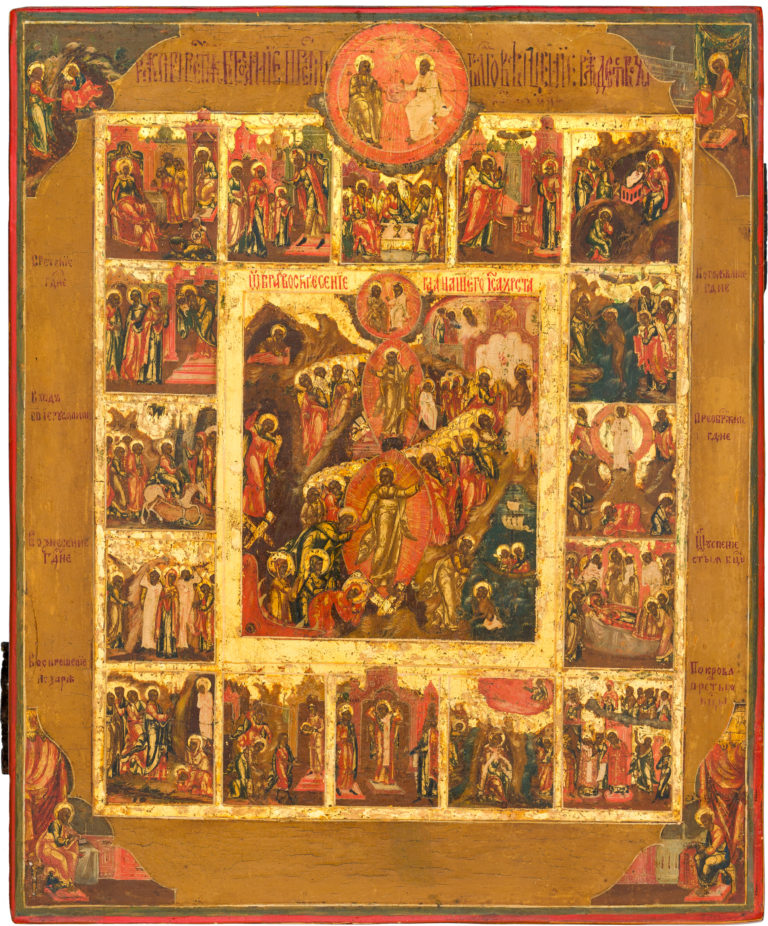The Resurrection—the Descent into Hell, with Church Feasts, the Holy Trinity, and the Four Evangelists
Antique Russian icon. Around the middle of the 19th century. Icon painting villages of the Vladimir region (possibly Palekh).
Size: 27.5 х 22 х 2 cm
Wood (one whole panel), two incut profiled support boards, a shallow incut centerpiece, underlying layer of gesso is not visible, gesso, tempera.
The author’s paintwork is in a satisfactory state, a bit chafed, the surface is covered with small fallouts of paint, gesso is absent on the borders. In the lower border, there is a candle burn covered with restoration toning.
On the reverse, under the lower support board, there is a pencil inscription: “Н.М.” Between the support boards, there is a barely readable inscription made in ink (in two lines).
Contact us

The Resurrection—the Descent into Hell, with Church Feasts, the Holy Trinity, and the Four Evangelists
Diagram of the border scenes:
- The Nativity of the Mother of God;
- The Entrance of the Mother of God into the Temple;
- The Old Testament Trinity;
- The Annunciation;
- The Nativity of Christ;
- Candlemas (The Meeting of Christ in the Temple);
- The Theophany (The Baptism of Christ);
- The Entrance into Jerusalem;
- The Transfiguration;
- The Ascension;
- The Dormition of the Mother of God;
- The Raising of Lazarus;
- The Beheading of John the Baptist;
- The Elevation of the Holy Cross;
- The Fiery Ascent of the Prophet Elias;
- The Pokrov (The Feast of the Protective Veil of the Mother of God);
- The New Testament Trinity (The Enthronement);
- The Evangelist John the Theologian;
- The Evangelist Matthew;
- The Evangelist Mark;
- The Evangelist Luke.
In the Imperial period, hand-painted icons bearing the depictions of the Resurrection – the Harrowing of Hades surrounded by border scenes with the Twelve Great and Minor Church Feasts became increasingly popular. In folk culture, they began to play the role of an agricultural calendar, with the cycle closely linked to the liturgical year. Such religious icon paintings became widely commissioned and were created by various masters ready to meet the demand of any Russian social class. Palekh was especially keen on the creation of these “Festive” holy icons, with local artists developing and standardizing their iconography and style. The centerpiece of such antique Russian icons usually contains the detailed iconography of the Resurrection of Christ, with the scenes of the Rising from the Tomb and the Harrowing of Hades placed along a single axis and connected by a diagonal processional line of the Pious marching from the Gates of Hell to the Kingdom of Heaven. The composition often includes the depiction of Heaven itself, where we see the Good Thief (Rach) conversing with the Prophets Elias and Enoch. This religious icon composition is surrounded by other scenes that took place before or after the Resurrection: in the upper left – “Saint Peter at the Empty Tomb,” in the lower right – “The Revelation of Christ to the Apostles on the Sea of Galilee.” The border scene cycle is highly traditional in its iconography and execution: it contains 16 border scenes that give a chronological narrative of the Gospel events and the Twelve Great Feasts that reveal the symbolic meaning of Christ’s sacrifice. The inclusion of the Old Testament Trinity into the upmost tier (breaking the liturgical chronology of Feasts) is a typical element of the iconographic scheme developed by Palekh’s religious icon painters. The composition is further supplemented by the New Testament Trinity (Enthronement) placed in the upper tier, which is also typical for complex Palekh hand-painted icons, the border scenes of which were often selected by the commissioner. In the given antique Russian icon, the lower tier of the border scenes includes the Fiery Ascent of the Prophet Elias and the Elevation of the Holy Cross – the feasts, in honor of which two of Palekh’s churches were consecrated. In the corners of this religious icon, we also see the depictions of the Four Evangelists: John the Theologian, Matthew, Mark, and Luke.
Stylistic traits of the given antique Russian icon – the miniature, draft-like manner of painting, the subtle, slightly dark color pallet, the dry gold hatching on the vestments – are typical for the traditionalist movement popular in the mid 19th-century Russian iconography. Traditionalist artists did seek to imitate Palekh religious icon art but in a simplified manner. Such hand-painted Orthodox icons were especially popular with the Old Believers, who commissioned them both – in Palekh and in other “imitation-prone” centers, which makes their attribution increasingly complicated.